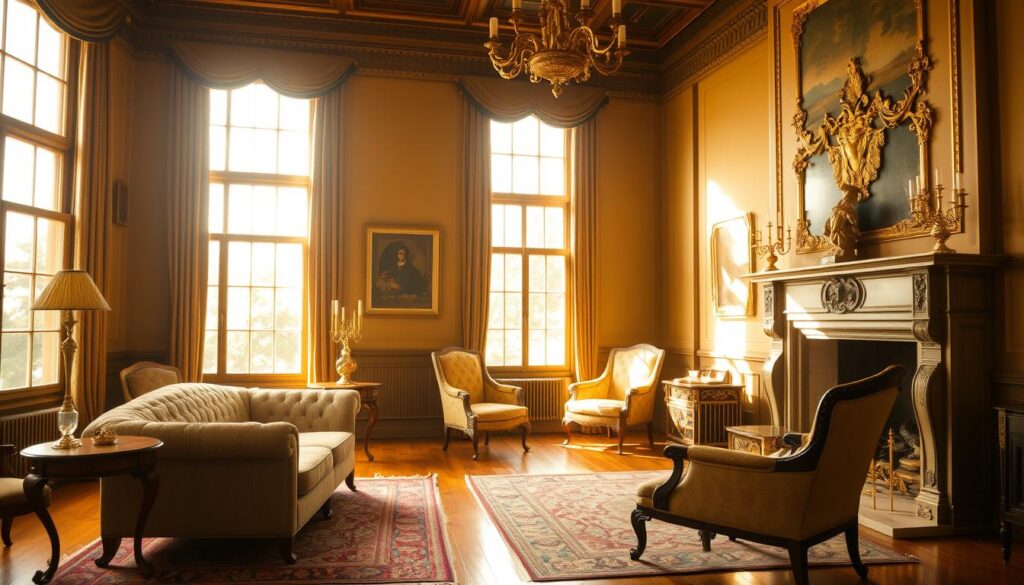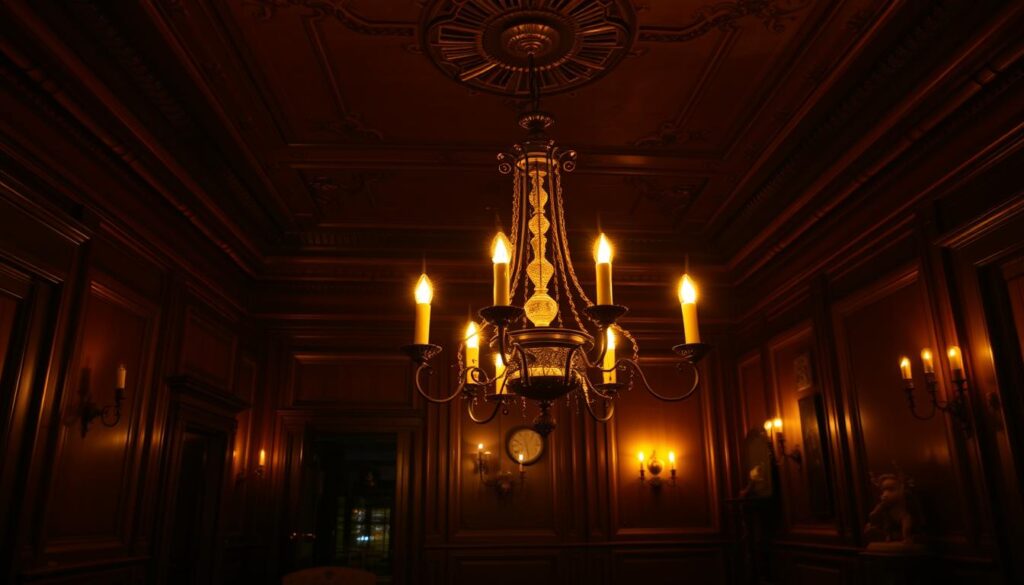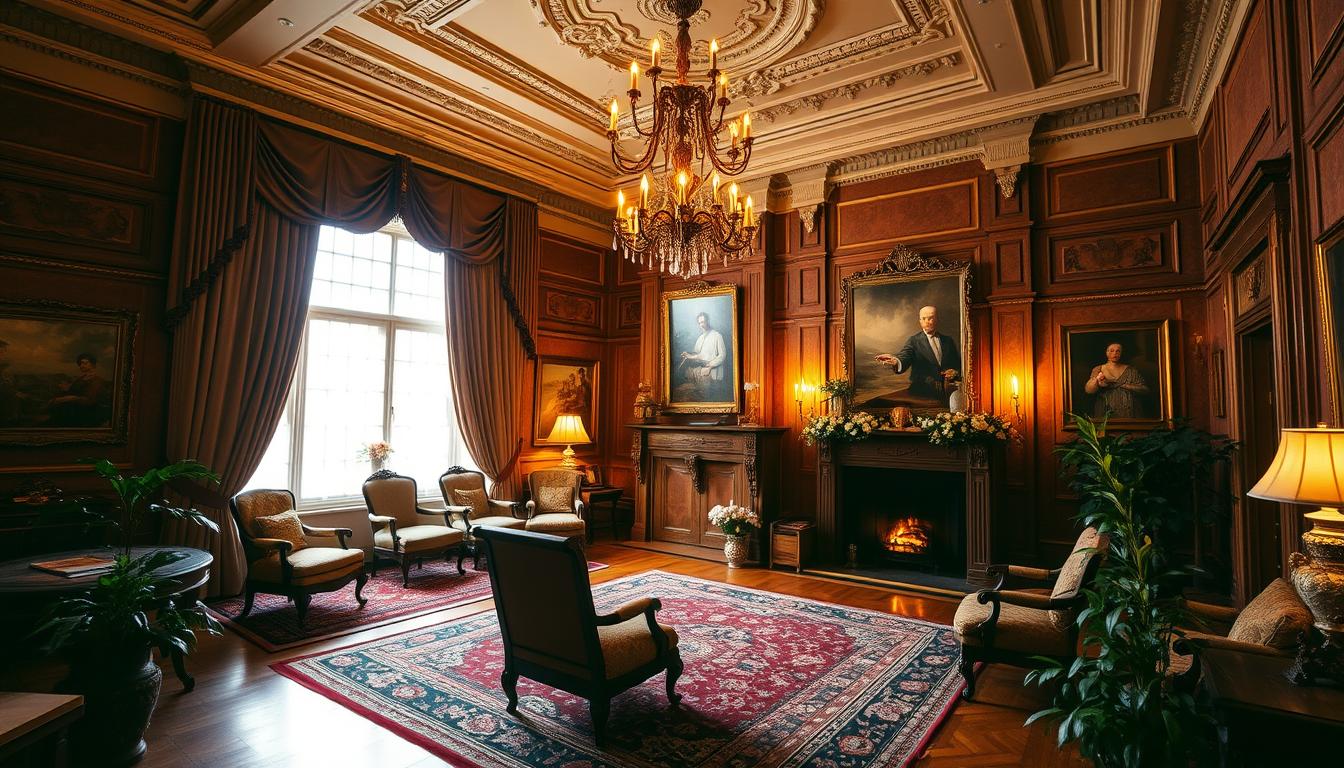Did you know that historic homes are more than just old buildings? They hold timeless elegance and tell stories of the past. When we talk about historic home interior design, it’s about mixing old charm with today’s style. This creates spaces that are both sophisticated and welcoming.
The core of this design philosophy is knowing the past well and paying attention to details. We’ll explore the key principles behind timeless elegance in these homes. You’ll learn how to bring this beauty into your own home.
Key Takeaways
- Understanding the principles of historic home interior design
- Blending classic elements with modern sensibilities
- Achieving timeless elegance in your home
- Preserving the essence of a bygone era
- Creating sophisticated and inviting spaces
Understanding Historic Home Interior Design
Historic home interior design is about keeping the past alive. It’s about bringing old homes into today’s world in a classy and true way.
The Definition and Importance
It’s more than a style; it’s about keeping history and culture alive. Homeowners keep the past’s spirit by using original parts. Architectural historian, James Marston Fitch, once said, “The historic house is not just a museum piece, but a living, breathing entity that connects us to our past.”
“The historic house is not just a museum piece, but a living, breathing entity that connects us to our past.”
This style focuses on details and staying true to the past. It’s not just copying old times but understanding the importance of each design element.
Key Style Influences
Many styles have shaped historic home interior design. These include:
- Neoclassicism, with its focus on classical looks and balance.
- Arts and Crafts, which values handmade items and natural materials.
- Victorian, famous for its fancy decorations and intricate designs.
Knowing these styles helps homeowners choose the right design elements. This ensures their homes are both stunning and historically meaningful.
Popular Architectural Styles and Their Features
Knowing the architectural style of a historic home is key for a true and unified interior design. Each style has its own features that help create a space that looks right for its time.
Colonial
The Colonial style is all about simplicity and balance. Colonial homes often have classical details like columns and ornate moldings. Inside, you’ll find traditional touches like hardwood floors and classic furniture.
For more on Colonial style homes, check out BHG’s guide on house styles.
Victorian
The Victorian era is famous for its fancy and detailed designs. Victorian homes are known for rich colors and patterned textiles. Inside, you’ll see complex patterns and carved wood, showing off the era’s love for luxury.
Craftsman
The Craftsman style loves handcrafted items and nature. Its interiors have exposed beams and built-in cabinetry. It focuses on natural materials like wood and stone, making spaces feel cozy and welcoming.
Understanding these architectural styles helps homeowners choose the right interior design. This way, their historic home stays true to its beauty and authenticity.
Selecting a Color Palette for Historic Homes
A well-chosen color palette can give a historic home a new life. It keeps the vintage decor ideas alive. The right colors can also make the home’s style stand out and blend old and new beautifully.
Classic Color Schemes
Classic color schemes for historic homes use soft, muted tones. These colors match the home’s style. They often include:
- Soft whites and creams
- Muted blues and greens
- Warm beiges and taupes
Together, these colors create a timeless and elegant feel. They honor the home’s original charm.
How to Use Bold Colors
Bold colors can also add personality to a historic home. To use them well:
- Begin with a neutral base color for a calm background.
- Make bold colors accent colors to add interest.
- Pair bold colors with softer tones to avoid too much.
This way, you can make a unique and visually appealing color scheme. It will enhance the home’s historic charm.
Choosing the Right Furniture
Furniture is key in bringing a historic home to life. It must be both functional and true to the period. Homeowners often face a choice: real antiques or modern copies.
Authentic Period Pieces
Real antiques bring a touch of elegance and history to a home. They are known for their craftsmanship and materials. It’s important to pick furniture that fits the home’s era and style.
Tips for Selecting Authentic Period Pieces:
- Learn about your home’s era and style to find the right furniture.
- Look at the craftsmanship and materials to make sure it’s period correct.
- Get help from antique restoration experts to confirm the piece’s authenticity.
Modern Reproductions
Modern copies are a budget-friendly way to keep a home’s historic feel. They look like old furniture but are made with today’s materials and methods.
Benefits of Modern Reproductions:
| Feature | Authentic Period Pieces | Modern Reproductions |
|---|---|---|
| Craftsmanship | High-quality, traditional craftsmanship | Modern manufacturing techniques |
| Cost | Generally more expensive | More affordable |
| Durability | Can be durable with proper care | Often more durable due to modern materials |
Choosing between antiques and modern copies depends on budget, lifestyle, and taste. Knowing the differences helps homeowners pick furniture that adds to their home’s historic charm.

Importance of Textiles in Historic Design
Textiles are key in historic design, making spaces feel real and welcoming. They show off the era and add depth, making them vital in historic home decor.
Fabrics That Reflect the Era
Choosing the right fabrics is crucial for a true look in historic homes. Each era had its own fabrics. For example, velvets and silks were big in the Victorian era. Linens and cottons were more common in Colonial times.
Knowing these fabric associations helps homeowners pick the right ones for their home’s era. For more on textiles in historic homes, check out “Understanding the Use of Textiles in Historic Homes.
Tips for Mixing Patterns
Mixing patterns needs careful thought. To look good, balance scale, texture, and color. Here are some tips:
- Begin with a main pattern and add secondary ones that match it.
- Combine different textures, like smooth silks and rough linens, for depth.
- Use a common color thread to link different patterns.
| Era | Popular Fabrics | Pattern Characteristics |
|---|---|---|
| Colonial | Linens, Cottons | Simple, geometric patterns |
| Victorian | Velvets, Silks | Intricate, floral patterns |
| Craftsman | Wools, Cottons | Earth tones, simple motifs |
By grasping the role of textiles in historic design, homeowners can craft interiors that are stunning, authentic, and full of meaning.
Decorative Elements that Enhance Historic Interiors
Decorative elements are key to bringing out the charm of historic interiors. They add sophistication and historical accuracy. By using these elements wisely, we can make a space that truly captures the era and style of the home.
Crown Molding and Trim
Crown molding and trim add elegance to historic interiors. Crown molding helps walls and ceilings blend smoothly, adding depth and interest. The molding’s style should match the home’s era and architecture.
Fireplaces and Mantels
Fireplaces and mantels are both functional and decorative. A well-made mantel adds warmth and character. The fireplace itself is a stunning focal point. It’s important to pick a style and material that fits the home’s era.
For example, Victorian homes often have intricate marble mantels. Craftsman homes might have simpler, rustic designs. Choosing elements that match the home’s history creates a cohesive look.
Antique Hardware
Antique hardware adds authenticity to historic interiors. From door handles to cabinet knobs, it’s a detail that shows the home’s era and style. When picking antique hardware, look at the material, design, and finish to match the home’s aesthetic.
| Decorative Element | Style Considerations | Materials |
|---|---|---|
| Crown Molding | Profile and design reflective of the home’s era | Wood, plaster |
| Fireplaces and Mantels | Style and intricacy appropriate to the home’s style | Marble, stone, wood |
| Antique Hardware | Design and finish consistent with the era | Brass, bronze, iron |
By carefully choosing these decorative elements, we can enhance a home’s historic charm. Whether it’s crown molding, a fireplace, or antique hardware, each element adds to the home’s rich history and beauty.
Creating a Cohesive Look
A well-designed historic home interior blends past and present seamlessly. Homeowners must balance preserving the home’s historic charm with modern elements. This balance enhances both functionality and beauty.
Balancing Old and New
Mixing old and new is key in historic homes. This can be done by:
- Pairing antique furniture with modern upholstery
- Incorporating contemporary lighting fixtures alongside traditional lamps
- Using modern materials and finishes that respect the home’s original character
By carefully combining old and new, homeowners create a unique and captivating space. This space honors the home’s history while meeting today’s needs.
Focal Points in Historic Spaces
Focal points add visual interest to historic interiors. Effective ways to create them include:
- Highlighting architectural features like fireplaces or crown molding
- Using statement pieces of furniture or artwork
- Creating a bold accent wall with a rich, historic color
These elements draw the eye to specific areas. They add depth and visual appeal to the room.
Creating a cohesive look in a historic home needs a thoughtful approach. By balancing old and new and creating focal points, homeowners can make a beautiful and functional space. This space respects the home’s heritage.
The Role of Lighting in Historic Design
In historic homes, lighting is key to bringing out the architecture and creating a cozy feel. The right lighting can greatly change how a historic home looks and feels. It’s important to pick the right fixtures and techniques.
Period Lighting Fixtures
Choosing the right lighting is crucial for keeping a home’s historic feel. Fixtures that match the home’s era are essential. For example, in a Victorian home, you might choose ornate gas lamps or chandeliers to show off the period’s luxury.
Some popular fixtures include:
- Candelabras and sconces for a classic look
- Chandeliers for grand rooms
- Lanterns for outdoor or entryway lighting
| Era | Typical Lighting Fixtures | Characteristics |
|---|---|---|
| Victorian | Ornate gas lamps, chandeliers | Ornate, elaborate designs |
| Colonial | Candles, simple lanterns | Simple, rustic |
| Craftsman | Handcrafted metal fixtures, pendant lights | Focus on handcrafted quality, natural materials |
Natural Light Considerations
Natural light is also vital in historic home design. It makes spaces feel bigger and more welcoming. Homeowners can use skylights or bigger windows to let in more light.
Mirrors can also help reflect natural light, spreading it around the room. When using natural light, it’s important to keep historic windows and features intact.

By picking the right lighting and using natural light, homeowners can make their historic homes warm and inviting. This approach keeps the home’s historic charm while making it beautiful and functional.
Preserving Historic Details During Renovation
Renovating a historic home is a careful dance. We must keep its charm while adding modern touches. It’s vital to respect its historical value.
Working with Historic Preservation Guidelines
Renovating a historic home means following local preservation rules. These rules protect the home’s original look and feel. Following these guidelines keeps the home’s history alive and can even boost its value.
Tips for Maintaining Authenticity
Keeping a historic home true to itself requires careful steps. We focus on saving original parts like crown molding, hardwood floors, and antique hardware. When repairs are needed, we use traditional methods and materials.
Choosing the right fixtures and fittings from the same era is also key. Documenting the renovation with photos helps keep the home’s history alive.
It’s important to be accurate with our changes. We research the home’s era and style to make sure our work is both beautiful and respectful of history.
Integrating Modern Amenities
Historic homes are true treasures, but they need modern updates for today’s lifestyle. We must keep their architectural and historical value while adding modern comforts. This makes them more functional and comfortable.
Modernizing a historic home means keeping up with technology. Installing smart home devices for remote control of lights, temperature, and security is key. Fast internet is also crucial for remote work or streaming.
Keeping Up with Technology
To blend technology with a historic home, consider these tips:
- Choose devices that look good and fit the home’s style.
- Go for wireless options to hide cables and wires.
- Make sure new installations don’t harm the home’s original look.
Ensuring Comfort and Functionality
Comfort and function are vital in a historic home. Here’s how to achieve it:
- Update to modern, energy-saving appliances.
- Choose ergonomic furniture that’s comfy and fits the home’s look.
- Renovate bathrooms and kitchens with modern features while keeping their charm.
By adding modern amenities thoughtfully, we can keep historic homes’ essence. At the same time, we make them more suitable for today’s living.
Inspiration from Historic Homes Across the U.S.
Historic homes across the United States are full of inspiration for those wanting timeless elegance in their homes. We can learn from iconic homes like the Biltmore Estate and the White House. They show a variety of design ideas that reflect classic interior design trends.
Iconic Examples
The Biltmore Estate in Asheville, North Carolina, and the White House in Washington, D.C., are famous for their design. They offer a peek into the past with their detailed designs and classic colors. These homes still inspire many today.
Incorporating Inspiration
To bring inspiration from these homes into our own spaces, we can look at their architectural style, decorations, and colors. By using elements from the past, we can make our homes unique and elegant. This way, we can show off our personal style while drawing from historic homes.


